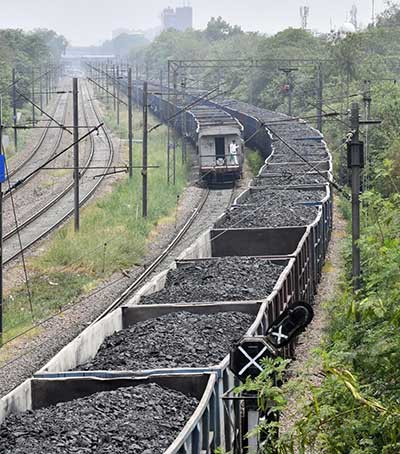Relevance: GS-3: Indian Economy and issues relating to planning, mobilisation of resources, growth, development, Infrastructure: Energy, Ports, Roads, Airports, Railways.
Key Phrases: Unprecedented Cancellation of Passenger Trains, Large-Scale Power Shedding, Disconnection of power supply, Widespread Power Cuts, Long-Term Power Purchase Agreements, Poor Infrastructure, Inefficient Operations.
Why in News?
- Recently, there was an unprecedented cancellation of passenger trains to run more freight trains to carry coal to power plants facing coal shortages.
- There were repeated announcements of large-scale power shedding and reports of disconnection of power supply by a distribution company to over 3,200 slum dwellers in Mumbai due to non-payment of accrued dues of over ₹102 crore.
- After nearly a decade of stable power availability, the country saw widespread power cuts, even before the onset of the peak summer season, which has now worsened in the present heatwave in large parts of the country.
Key Highlights:
- India is the third-largest producer of electricity in the world with an installed capacity of about 400 GW.
- Notwithstanding the recent emphasis, renewable energy accounts for only 39 per cent (50 GW Solar, 46 GW Hydro and 40 GW wind).
- Coal for electricity is not only harmful for the environment, it is also inefficient; 400 gram of coal is burnt to generate every one unit of electricity (1kwh).
- In pre-pandemic 2019-20, India’s per-capita, annual power consumption was 1,208 kWh as against the world average of 3,260 kWh and far less than 10,000-15,000 kWh for developed countries.
- As our economy grows, with the increase in industrial and manufacturing activities coupled with urbanisation, this number is bound to increase considerably.
History of Transportation in India:
- There is a legacy of interdependence between coal, electricity, and trains.
- Transportation was revolutionised in India when the British decided to connect ports of the Presidencies with the hinterland to facilitate military and commercial movement of raw material from the hinterland to ports and import of finished goods in return.
- The Geological Survey of India, founded in 1851 by the East India Company, focussed on the exploration of coal for powering steam transport, and for the next 140 years or so, Indian Railways (IR) burnt billions of tonnes of coal to haul trains.
- Although IR retired its steam locomotives by the 1990s, 51 percent of electricity in India is generated by burning coal in power plants, with coal transported mainly by IR.
Where do we stand on green energy?
- The report ‘Delay in execution/completion of Power Project’ by the Parliamentary Standing Committee on Energy (2020-21), Ministry of Power, observed that 12 out of 13 hydropower projects suffered a total time overrun of 1,205 months and cost overrun of ₹31,530 crores.
- Such delays in the execution of renewable energy projects may prolong our dependence on thermal power.
Issues with the Power Sector:
- Delays in Project Completion:
- There are considerable time and cost overruns in the completion of thermal projects, development of coal mines, installation of efficient evacuation facilities by Coal India, and capacity augmentation for faster transport of coal by IR.
- The common reasons for delays are environmental issues, land acquisition, rehabilitation and resettlement, capacity constraints, and contract management.
- Power Distribution Losses:
- The NITI Aayog report of August 2021, ‘Turning around the Power Distribution Sector-Learnings and Best Practices from Reforms’ has estimated losses of the distribution sector of the order of ₹90,000 crores for FY 21
Way Forward:
- Improving Performance of Power Distribution Utilities:
- There is a need to look at the performance of power distribution utilities, many of which make losses for various reasons like poorly-thought out long-term power purchase agreements, poor infrastructure and inefficient operations.
- This puts further constraints on them from investing to improve the quality of power supply and install required infrastructure for renewable energy, apart from the cascading ill-effects of non-payments to power generation entities.
- Collaboration of Power, Coal and Railways:
- The three interdependent entities or a group of entities managing power, coal, and Railways have to work in tandem with increased efficiency.
- Availability of power is a pre-eminent requisite for India to achieve the goal of $5 trillion economy and for this more capacities need to be built and utilised efficiently and the supply chain, even if it is going to be coal, transported by IR for years to come, be managed effectively.
- Increased Transportation Efficiency:
- IR must address the issue of faster transportation on dedicated corridors with efficient freight wagons.
- Greater Political Will:
- There is perhaps a need for greater political will as the bureaucracy in these core ministries has not been able to align itself with the prime national goals.
Conclusion:
- If these issues are not addressed, the government's goal of providing assured 24X7 power for all would be a distant goal.
- The rich may continue to have power from DG-sets, but the less privileged will be forced to use candles more often, which is unacceptable, and, of course, a more expensive alternative.
Source: The Hindu BL
Mains Question:
Q. Availability of power is a pre-eminent requisite for India to achieve the goal of $5 trillion economy and for this more capacities need to be built and utilised efficiently. In this respect, discuss the challenges associated and suggestions for improving the efficiency of the power sector. (250 words).








